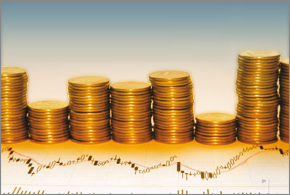|

The name ‘gilts’ says it all. Sovereign debt issued
by the British government and backed by the Bank of England,
gilts are the bedrock of a long-term investment plan, the foundation
for pension funds, the girders of insurance schemes. And it’s
the same with the sovereign debt of other well-managed countries.
As David Roche, president of investment strategists Independent
Strategy explains, such debt is “the touchstone by which
other riskier financial assets are priced.”
The massive amounts of sovereign debt issued by USA and western
Europe to save their own or other economies such as Greece’s
has rewritten the rules. The world is now awash with sovereign
debt, some of it of dubious quality, and the investment world
worries if it’s all going to get paid back.
The €750 billion (£650 billion) that EU nations,
European Central Bank and IMF stumped up to rescue Greece illustrates
the size of the problem.
The result is a mounting fear of contagion – that is,
one country’s excessive issues of sovereign debt dragging
down the value of another. Virtually overnight, gilts and ‘sovs’
have become, if not risky assets, certainly not the unimpeachable
instruments they have been for half a century or more.
As Daniel Sheppard of Deutsche Bank Wealth Management says,
expressing fears about future downgrades as a result of the
contagion: “We are in the age of worrying about sovereign
debt,” he confirms.
Gilt ridden
There’s an awful lot of sovereign debt out there compared
with happier times. The public, that is, government-issued debt
of most western European nations, is running at over 100% of
gross domestic product after rising by nearly 70% in the last
four years.
In the early years of the millennium, this would have been
considered an unthinkable, even horrifying scenario. Indeed,
the last time we saw this was in the 1939-45 war when governments
were printing money like confetti to feed the war machine.
|
 |
So does it make any sense to invest in gilts or their international
equivalents? Certainly, argues Jeremy Batstone-Carr, an analyst
at Charles Stanley and an authority on sovereign debt. Just
one reason for his continuing faith in gilts is that they will
continue to form an albeit reduced bedrock of pensions funds
and other long-term savings programmes. “Actuaries will
continue to encourage pension-fund managers into bonds,”
he predicts. However, as we’ll see, the somewhat tarnished
world of gilts – in the western world anyway – has
changed some of the rules of the game.
Vested interest
So what exactly is, or was, so great about a gilt? First, it’s
a loan to the government at a fixed rate of interest –
the coupon. As such, it has the absolute backing of the government.
On the date of redemption, investors will get their money back,
plus interest along the way. Second, a gilt/bond delivers what’s
known as a yield. That is, a combination of the nominal rate
of interest, say 5% over the life of the instrument, plus capital
gain. These interest payments are sometimes known as the ‘running
yield’. The upshot is that however badly a gilt turns out
because of outside economic forces, holders can always bank
on a stream of interest payments.
However, it’s the capital gain – or loss – that
most concerns bondholders. Although gilts are described as fixed-interest
instruments, they aren’t really because the return fluctuates
according to the price at which the gilt is bought and sold.
This is known as the gross redemption yield including capital
gain before taxes, if any. Additionally, the capital gain depends
on prevailing levels of inflation and of interest rates over
the life of the bond. A general rule of thumb decrees that gilt
prices rise when interest rates fall. Obviously, gilts with
higher coupons become more attractive when succeeding paper
is issued at lower coupons.
Of course, the opposite applies. Rising interest rates can
soon turn gilts with low coupons into dross. This is why the
value of gilts and sovereign bonds in general fluctuate from
month to month, year to year, and sometimes day to day as we’ve
seen with Greek bonds.
Skilled bond investors watch inflation rates like a hawk. Nothing
cheapens a bond faster than rampant inflation because it drives
up interest rates. Fortunately, the weight of opinion is that
the western world is heading into a sustained bout of deflation,
which is generally good for bonds. And if it doesn’t, index-linked
bonds are one way of covering that risk.
That doesn’t mean that sovereign bond-holders haven’t
got their fingers crossed. ‘A repricing of sovereign debt
as dangerous debt would be an earthquake for financial markets,’
adds Roche, who has just written a book with economist Bob McKee
called Sovereign DisCredit about the dangers lurking in the
current situation.
|
 |
RISING YIELDS PREDICTED
In gilts, size matters. The higher the debt and/or deficit
of a nation, the more investors worry about the long-term integrity
of that country’s issuance in the technical phrase (Greece,
for example). This is because heavily indebted countries often
have to pay a premium on the coupon to get investors to take
up their bonds.
As the bullet points demonstrate (above right), by that score
the national deficits of the 30 members of the Organisation
for Economic Co-operation and Development (OECD) suggest rising
yields for years to come.
BETWEEN 2007-2010
- The deficit, which is the difference between earning and
spending in the OECD’s 30 nations, grows nearly sevenfold
to about $3.4 trillion.
- Their total debt burdengrows to a record $43 trillion.
- In the eurozone, natural deficits grow
|
|
Why? Because these nations run conservative public finances
with all the right fundamentals: low debt, strong economies,
low budget deficits, current account surpluses, healthy foreign
exchange reserves and high sovereign credit ratings.
Therefore, in a changing of the guard, savvy investors are
buying into the bonds from countries such as Brazil, Russia
and Egypt among many others. The implication, point out professional
investors, is that there’s nothing wrong with sovereign
bonds. What’s important is the country that issues them.
Timing is everything The lesson for gilt-buyers in this more
volatile world, explains Jeremy Batstone-Carr, is to take a
much more active interest in their investments. ‘The old
days of buy-and-hold are well and truly gone,’ he warns.
‘Once the investment is made, investors must become much
more involved in their portfolio.’ This means the term
of a gilt – whether two, five or 30 years – is less
important than its value at any given time.
‘There should be no real time element,’ he explains.
‘The only important factor is its performance.’ However,
in a turbulent world, most investors in sovereign bonds are
going for the medium-dated paper of around five years. ‘Anything
short or long looks risky,’ adds one source.
And yet, the world’s biggest investors continue to mop
up sovereign debt, but not in the same way as before. Pimco,
the world’s second largest owner of bonds, is buying into
emerging markets and reducing its exposure to Britain and certain
other western nations. Similarly, Aviva Investors has more than
doubled its holdings of these assets.
|








